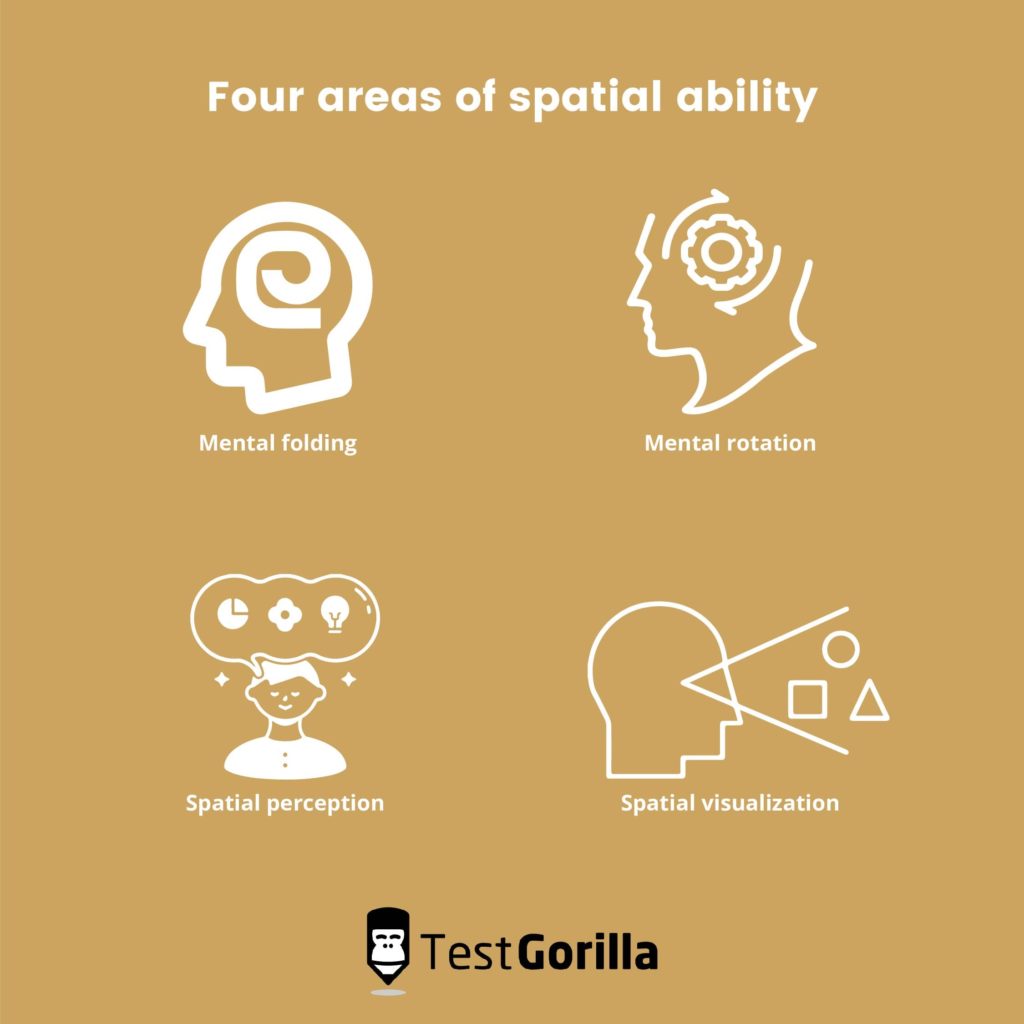Like all other primates, humans are visual creatures. Visual information helps us think, perceive, draw, and even learn.
In reality, visual (or “spatial”) intelligence is one of the many forms of intelligence that a person might incline towards.
Spatial reasoning is crucial for problem-solving, analytical thinking, and information organization, making it vital in the workplace. So it’s no surprise that spatial reasoning tests have gained popularity, particularly in STEM (science, technology, engineering, and math) professions where spatial capabilities are essential to job success.
So, what exactly is a Spatial Reasoning test and why is it significant?
How can you use it in your hiring process to improve your business?
In this article, we’ll discuss all this, and more.
Table of contents
- What is a spatial reasoning test?
- The importance of spatial reasoning skills
- What are the types of skills assessed in a spatial reasoning test?
- What do spatial reasoning tests measure?
- When should you use a spatial reasoning test?
- What are the benefits of a spatial reasoning test?
- Why should you use TestGorilla’s Spatial Reasoning test?
What is a spatial reasoning test?
A Spatial Reasoning test assesses a candidate’s ability to interpret spatial objects (2D and 3D). Understanding, reasoning, and recalling the links between items or space are all covered in the test.
If you’ve ever tried to solve a Rubik’s cube, you’ve completed a type of spatial reasoning test.
A spatial reasoning test, in reality, includes (and measures) four separate areas of spatial ability:
Spatial perception. Consider, for example, a first-person shooting game where you have to move through a maze—this is where spatial perception comes into play.
Mental rotation. This is the essence of the Rubik’s Cube.
Spatial visualization. Spatial visualization is about developing internal knowledge through imagery to visualize details, shapes, motions, measures, etc. This is especially significant in STEM fields.
Mental folding. This is a complex spatial visualization skill that requires the translation of two-dimensional patterns into three-dimensional patterns, or 2D into 3D. If you’ve attempted Origami, you’ve most likely already done this, and architects and mechanical engineers are required to perform this regularly.
Spatial reasoning tests typically cover these four central spatial skills and can assist you in identifying the candidates who have the right spatial reasoning skills throughout the hiring process.
The importance of spatial reasoning skills
For jobs where you need visual thinking, spatial reasoning skills are essential. If you’re hiring for one of the following positions, consider giving them a Spatial Reasoning test:
Mechanical engineer
Graphic designer
Management consultant
Architect
Physicist
CNC programmer
Photographer
Chef
Air traffic controller
For the best results, we advise you to combine this test with other pre-employment skills tests in order to create a detailed skills assessment, which would allow you to accurately assess your candidates’ strengths and abilities.
The higher the candidate’s score, the better qualified they will be for the position they are applying for.
What are the types of skills assessed in a spatial reasoning test?
When it comes to the spatial test itself, several types of spatial reasoning questions assess various spatial reasoning skills.
Here are some of the types:
Shape matching
Group rotation
Cube views
Mirror images
Fitting the pieces of two-dimensional shapes
Block counting
Maps and graphs
Each of these categories evaluates one of the four primary spatial thinking abilities.
What do spatial reasoning tests measure?
Strong spatial thinkers can usually immediately identify a link or pattern between objects or space. To objectively assess this ability, a spatial reasoning test often evaluates the candidate’s ability to:
Grasp how various processes or practices interact with one another
Participate in several visual simulations at the same time
Manipulate, comprehend, and employ visible entities
These skills are critical for anybody working in STEM, design, or medicine. For example:
A chemist must be capable of understanding the models used to depict molecules and formulae
An astronomer must be able to visualize the motion and structure of objects within solar systems
An engineer must be able to understand how the different pieces of a machine will operate together in sync even before he begins building it
This is how spatial reasoning skills translate into day-to-day business responsibilities.
When should you use a spatial reasoning test?
The Spatial Reasoning test is best used as a part of the screening process, before you invite applicants to an interview, in order to determine who your strongest applicants are.
For the best results, we advise combining it with other pre-employment tests, such as:
You can combine up to five skills tests and personality assessments to gain an in-depth understanding of the skills, behavior and personality traits of your candidates, and evaluate their performance potential.
There are several reasons why you should use a spatial reasoning test during recruitment. A spatial reasoning test:
Saves time and resources, since you won’t have to interview people who fail the test and aren’t qualified for the role
Improves the candidate experience, as it shows applicants you value both their skills and time
Aids in predicting a candidate’s job success, as, according to research, tests are stronger predictors of job success than years of experience or education
Learning and development
You can use skills tests to support your learning and development initiatives and assess their efficiency.
Recent research has revealed that training can help enhance spatial skills. A spatial reasoning test can help you evaluate where your employees stand in terms of spatial ability, identify specific gaps, and work with them to improve their skills.
Based on the results of the test, you can design specific training sessions that’d help your employees enhance their skills and deliver better results for your organization. After that, you can use a spatial reasoning test again to see what improved and what didn’t, in order to further tweak your learning and development initiatives.
This can be a part of your onboarding process (for example, if you have used a skills assessment in recruitment), but you can also implement it at any point during the employee lifecycle.
You can use this approach for roles in engineering, STEM, and graphic design, to name a few.
What are the benefits of a spatial reasoning test?
A well-designed spatial reasoning test, such as the one we have on our platform, offers a variety of advantages for recruiting managers.
The right spatial reasoning test can help you:
Evaluate applicants objectively: A Spatial Reasoning test is an objective test used to assess spatial reasoning abilities. That means that it allows you to evaluate applicants objectively and fairly, giving everyone an equal chance and eliminating hiring biases.
Predict job performance: This test concentrates on a few essential qualities that, in combination with other skills you can evaluate with skills assessments, predict job success more accurately than a CV, work experience, or education. As a result, skills assessments are highly reliable and accurate.
Quickly screen applicants and identify the best talent: A spatial reasoning test helps the hiring team screen applicants effectively. As a result, you don’t waste time interviewing unqualified individuals, and they don’t waste time interviewing for a position they aren’t qualified for.
Optimize recruitment costs: The test is highly cost-efficient: prospective employees complete the exam remotely, and scores are automatically calculated. After that, you get an instant overview of your applicants’ performance.
Improve the quality of hire: A spatial reasoning test helps you hire qualified employees for your organization who can think strategically, pay attention to details, visualize and remember images, and identify patterns.
Why should you use TestGorilla’s Spatial Reasoning test?
There are plenty of pre-employment tests that would allow you to assess applicants’ spatial reasoning skills, but not all of them will provide you with accurate, reliable results.
There are several reasons you should choose TestGorilla when selecting a pre-employment skill testing platform to assess applicants’ spatial reasoning skills:
All our tests are developed by subject-matter experts. Everyone involved in developing our tests is a subject-matter expert in their relevant field, and they’re evaluated based on their knowledge, skills, and abilities. Additionally, all tests uploaded to our test library are continuously improved, evaluated, and updated.
Our platform will help you optimize the hiring process. Our platform is straightforward to use and helps you streamline and automate skills assessment, which is one of the most resource-intensive parts of the hiring process. This allows you to focus on what truly matters: evaluating your top applicants.
We help you provide a positive candidate experience. Our tests are created with candidate care in mind: they’re simple to administer and take, and you can customize them by including a short video and using your brand colors and logo. Moreover, skills tests show your candidates that you value their skills and talent above all else.
Our platform is data-driven. Our platform will automatically calculate your candidates’ test results, allowing you to quickly assess and compare applicants’ skills and strengths. As a result, your HR team will make recruitment decisions based on facts and data, and eliminate bias.
So, when selecting a Spatial Reasoning test for your hiring needs, choose the one that will help you hire the best candidate: TestGorilla’s Spatial Reasoning test.
Related posts
Hire the best candidates with TestGorilla
Create pre-employment assessments in minutes to screen candidates, save time, and hire the best talent.
Latest posts
The best advice in pre-employment testing, in your inbox.
No spam. Unsubscribe at any time.

Hire the best. No bias. No stress.
Our screening tests identify the best candidates and make your hiring decisions faster, easier, and bias-free.
Free resources
This checklist covers key features you should look for when choosing a skills testing platform
This resource will help you develop an onboarding checklist for new hires.
How to assess your candidates' attention to detail.
Learn how to get human resources certified through HRCI or SHRM.
Learn how you can improve the level of talent at your company.
Learn how CapitalT reduced hiring bias with online skills assessments.
Learn how to make the resume process more efficient and more effective.
Improve your hiring strategy with these 7 critical recruitment metrics.
Learn how Sukhi decreased time spent reviewing resumes by 83%!
Hire more efficiently with these hacks that 99% of recruiters aren't using.
Make a business case for diversity and inclusion initiatives with this data.





















